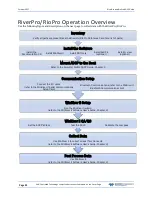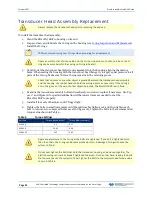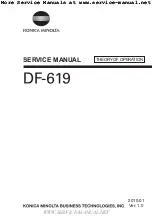
October 2017
RiverPro and RioPro ADCP Guide
Page 42
EAR-Controlled Technology Subject to Restrictions Contained on the Cover Page.
Cleaning the I/O Cable Connectors
After a deployment, clean and remove any accumulated sand or mud from the both the I/O connector on
the RiverPro/RioPro and the female socket on the I/O cable.
To clean the connectors:
1. Flush the connector pins and sockets with fresh water (deionized water if available) to remove all
dirt, grit, and lubricant.
2. Use a small stiff brush to remove any sand or mud from the connector. Wipe dry using a lint-free
wipe.
3. New lubricant must be applied again prior to connecting the dummy plug or cable.
Do NOT use spray-based contact cleaner. The use of some oil-based propellants in spray cans
can cause conductivity problems in neoprene.
Cleaning the Temperature Sensor Cover
In order to respond quickly to changes in the water temperature, water must be able to flow over the sen-
sor. Do not block the sensor or paint over it with antifouling paint. Remove any biofouling as soon as pos-
sible.
The temperature sensor is embedded in the transducer head (see Figure 12, page 38). The
sensor is under a titanium cover that is highly resistant to corrosion.
Removing Biofouling
To remove foreign matter and biofouling:
1. Remove soft-bodied marine growth or foreign matter with soapy water. Waterless hand cleaners
remove most petroleum-based fouling.
Do not use power scrubbers, abrasive cleansers, scouring pads, high-pressure marine cleaning
systems or brushes stiffer than hand cleaning brushes on the transducer faces. The urethane
coating on the transducer faces could be damaged.
If there is heavy fouling or marine growth, the transducer faces may need a thorough cleaning to
restore acoustic performance. Barnacles do not usually affect RiverPro/RioPro operation, but
TRDI does recommend removal of the barnacles to prevent water leakage through the transducer
face. Lime dissolving liquids such as Lime-Away
®
break down the shell-like parts. Scrubbing with
a medium stiffness brush usually removes the soft-bodied parts. Do NOT use a brush stiffer than a
hand cleaning brush. Scrubbing, alternated with soaking in Lime-Away
®
, effectively removes
large barnacles.
If barnacles have entered more than 1.0 to 1.5 mm (0.06 in.) into the transducer face
urethane, send the RiverPro/RioPro to TRDI for repair. If the barnacles cannot be removed
without damaging the transducer faces,
contact TRDI
.
2. Rinse with fresh water to remove soap or Lime-Away
®
residue.
3. Dry the transducer faces with low-pressure compressed air or soft lint-free towels.
Always dry the RiverPro/RioPro before placing it in the storage case to avoid fungus or mold
growth. Do not store the RiverPro/RioPro in wet or damp locations.
















































